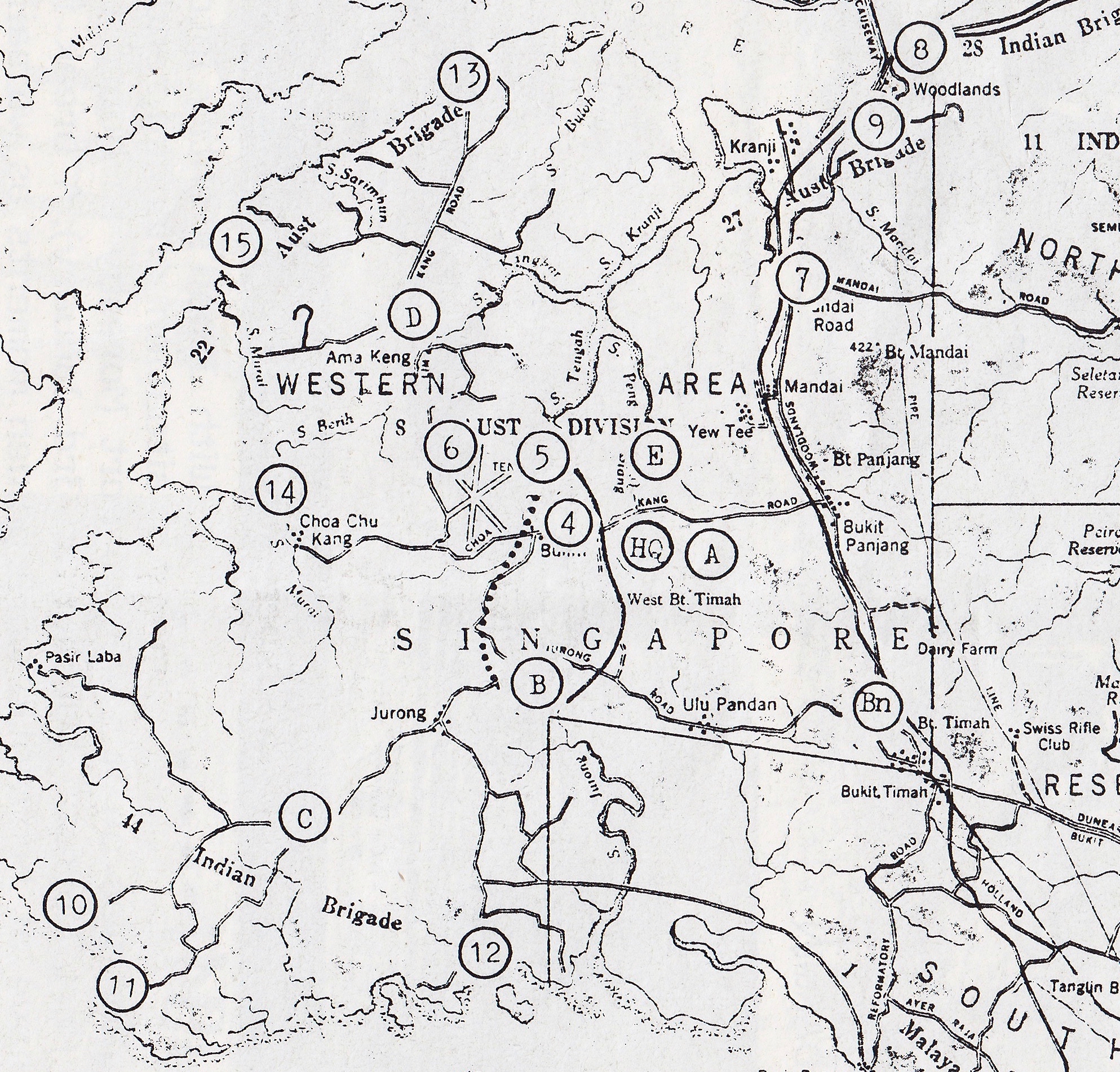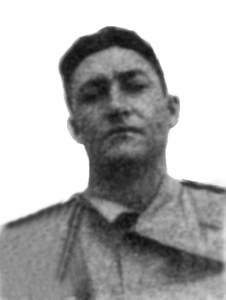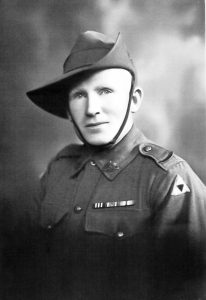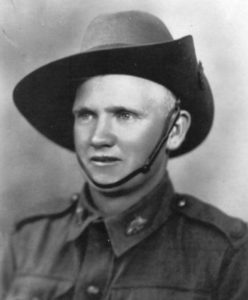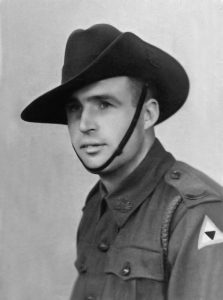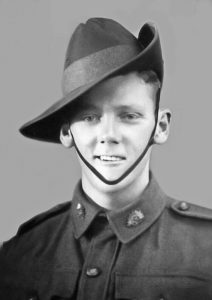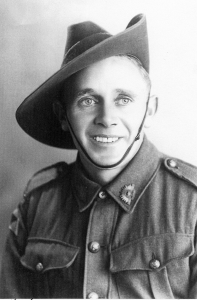‘Don Company formation of 16 Platoon
7 February 1942 a further platoon was created within Don Company – 16 Platoon was made up of 27 men transferred from D Company platoons (large number of these men were from the Fremantle area) The senior Officer was Sgt Ron Arbery. These 27 Men of 16 Platoon faced the Japanese invasion on 8th Feb 1942 dug into their pits on the shores of north-west Singapore.
Commanding Officer WX10787 Sgt R E Arbery (formerly 13 Platoon) was wounded at 0800 hours 8 Feb evacuated with gunshot wound to his scalp, he took no further part in the fighting.
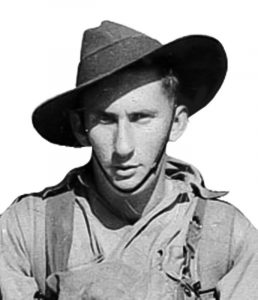
And 2 I/C Platoon Sergeant WX10609 Sgt J V Des Colevas (formerly 14 Platoon)
with crew of Tom Edwards, Charlie Holme and Bob Evan were in a completely isolated location.
Arbery was wounded at 0800 hours on 8 Feb 1942 with GSW to Scalp and was not discharged to Unit until 20 Feb 1942
Colevas received gunshot wound to left side of chest wall at Sungei Berih at 1000 hours on 9 Feb 1942. Evacuated, Colevas also took no further part in the fighting.
Admitted to Casualty Clearing Station then to Field Ambulance. Transferred to 2/13th AGH on 15 Feb and discharged to unit 22 Feb 1942. ‘D’ Force S Battalion to Burma-Thai Railway. ‘Rashin’ Maru to Japan. Recovered from Niihama. RTA
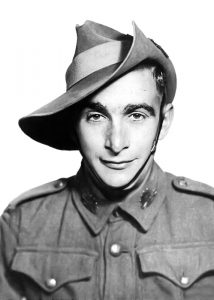
9 men lost their lives
and
WX7745 B G Harrison (formerly 15 Platoon) – disappeared/ did a runner when Arbery was leading the men out of their front line positions under heavy fire & about to fall to Japanese on night of 9 Feb 1942.
WX5073 Thomas Ashton Wood (formerly 14 Platoon) – Listed as missing from 9 Feb 1942. Escaped to Java.
WX17370 John Wilson – Reinforcement. Missing from action from 8 Feb 1942. Rejoined unit 15 Feb 1942.
By the end of war this 16 Platoon suffered another 4 deaths. Borneo – 2, ‘Rakuyo’ Maru -2.

‘D’ COMPANY HQ & PLATOONS 13, 14, & 15 (& 16)
In total ‘D’ Company had 15 guns on the northwest coast of Singapore as at 8 Feb, 1945.
Singapore’s defence plan was to man the coastline – the Australian forces were given the North West Sector.
With the exception of two Australian Brigades nearly every Battalion was short of equipment. The effective strength of what was 39 Battalions was in fact no more than 25 Battalions – many of doubtful value, to protect a 70 mile coastline.
AUSTRALIAN FORCES: Had 9 ½ miles of difficult coastline to protect. The Australian area was divided by the broad reaches of the Kranji River, and was hopelessly undermanned.
27th Brigade (2 Battalions) had the difficult Causeway-Kranji River section.
22nd Brigade (3 Battalions) had the eight mile NW coast Sector and was supported by 2/4th’s ‘D’ Company 13, 14, 15, and 16 Platoons
The Australians had to provide their own reserves (of which there were zero!)
Please read further about No. 13 Platoon
Vickers Machine Gun Companies
There were four Vickers Machine gun companies. Each company had its own HQ consisting of three platoons. In the case of ‘D’ Company HQ and Platoons 13, 14, 15 (and later in Singapore) No 16 Platoon was formed for defence of the west coast of Singapore (made up from Fremantle reinforcements and spare numbers from ‘D’ Company.)
Other Companies were:
‘A’ Coy HQ and No’s 4, 5, 6 Platoons
B’ Coy HQ and No’s 7, 8, 9 Platoons
‘C’ Coy HQ and No’s 10, 11, 12 Platoons
Each Machine Gun Platoon consisted of two sections each with two Vickers machine guns giving the Battalion a total of 48 Vickers machine Guns.
No. 1 and 2 on the gun were to be issued with revolvers, but in the case of 2/4th, this never happened.
Supposedly each Platoon was to be equipped with a Boyes Anti-Tank rifle – but these were never issued to 2/4th. For each platoon six 15 cwt trucks were provided, giving each Company a total of 21 vehicles.
The battalion was organised by attaching certain personnel from Battalion HQ and HQ Companies to the Machine Gun Companies – enabling each Machine Gun Coy to be self-contained administratively.
Battalion transport included 122 vehicles as well as motorcycles – the reason for the inclusion of a high number of driver trade groupings in the Battalion. The handling and maintenance of all these vehicles was paramount to the efficiency of the Battalion. Therefore the Transport Sergeant, Corporals and Light Aid Detachment (L.A.D.) who serviced these vehicles had a big responsibility to ensure serviceability of the Battalion’s transport.
‘D’ Coy No 14 and 16 Platoons supported 2/19th Battalion (Lt-Col Anderson VC/Lt-Col Oakes)
The wide expanse of the mouth of Sungei River (Berih) and estuary provided an ideal opportunity for deep penetration by Japanese landing craft – giving access to Tengah airfield and ability to attack the rear of 22nd Brigade which included the 2/19th which was located on the north side of the mouth. The 44th Indian Brigade was located south of Sungei mouth.
2/19th under leadership of Lt-Col Anderson and VC Lt-Col Oakes extended from the Murai to Berih Rivers and Choa Chu Kang Road with 14 and 16 Platoons of 2/4th Machine Gunners.
From ‘Singapore Story’ and described by Lt. Col Oakes of 2/19th Btn.
“…………a scraggy waste of stunted rubber and tangled undergrowth ……vision limited to the next rise in undulating ground ………movement confined to a few native tracks winding through the wilderness … the 2/28th away to the north in a similar desolation of waste and confusion ….
A mile of single track through the belukar (secondary jungle) 8 ft high to where D Coy overlooked the mangrove swamp …. under tide at high water. A wooden footbridge crossed the swamp to a small hill on the coast occupied by a platoon. On its southern flank the broad reaches and monotonous swamps of the Sungei (River) Berih. A long trek through more swamps and beluka brought us to another Platoon covering a hill on the coast large enough to be held at east by a Company …………….. the rest of B Coy was swallowed un in the ridiculous immensity of the area.”
Les Cody’s description of this area: ‘The estuary was really a large tidal basin 3/4 mile wide from north to south and twice that in length. This area required required additional machine guns – Platoon 16 was formed from spare gun numbers from the three platoons of “D” Company.’
16 Platoon was positioned on the exposed north headland of Tanjong Skopec with a section of two guns sited at the water’s edge and another, 400 yards further east covering a wide expanse of 4000 yd coastline.
Cody described one gun as being a ‘fluted barrel old-timer which could have been as old as Boer War’ was under Sgt Des Colevas and his crew – Tom Edwards, Charlie Holmes and Bob Evans. They were completely isolated. Dug in on the rear slopes of a rise set back some thousand yards from the coast – their responsibility was to cover the mile wide mouth of Sungai Beri (River) with no supporting infantry within call.’
(Tom Edwards DOW on 12 Feb 1942; wounded in a trench by a shell burst from enemy artillery fire at Hill 200, Ulu Pandan. Edwards was carried by stretcher bearers to RAP 100 yards away where Capt Anderson from 2/4th pronounced him dead.)
(Charlie Holme died Sandakan-Ranau track, Borneo 7 June 1945)
In Les Cody’s book ‘Ghosts in Khaki’ P. 107 is a copy of Lacey’s description waiting for the Japanese invasion.
Lacey Gibbs, 16 Ptn – 2 February 1941
“We are getting ourselves dug in waiting for the Japs and they tell us it won’t be long now. We were working late, till one o’clock in the morning getting our gun pit ready, up to our knees in mud and water. We are sleeping in the open and after knocking off we’re just going to open some rations when down came the rain. It was a real tropical downpour and you couldn’t see much more than 10 yards. We are working at night because we are under observation by the Japs over the Strait in daylight.
My bed, made out of a piece of wire netting is up a tree to keep me out of the mud – my hole (slit trench) is right below me. I have made use of it already; since I started to write this we have had two waves of Jap bombers over and the ack ack fire has been pretty heavy. We are set up in a coconut grove and there are plenty of nuts but they are hard to get down. Maybe the Japs will help by lobbing a few shells amongst them – as long as they give us time to get out!
We have been scouting the area looking for pigs and anything else edible but had no luck. There are some beautiful homes about here, all abandoned. It is sad to see so many groups going along the roads with their belongings on their backs. One lovely home near our position, set in lawns and gardens must have cost thousands to build. I found a very good fishing rod in one of the houses but it is pretty risky going fishing in daylight with the Japs camped across the water you could catch more than a fish.
We have to be careful with water, there is plenty about as the water table is pretty high but it all has to be boiled.
Now we just have to sit and wait.”
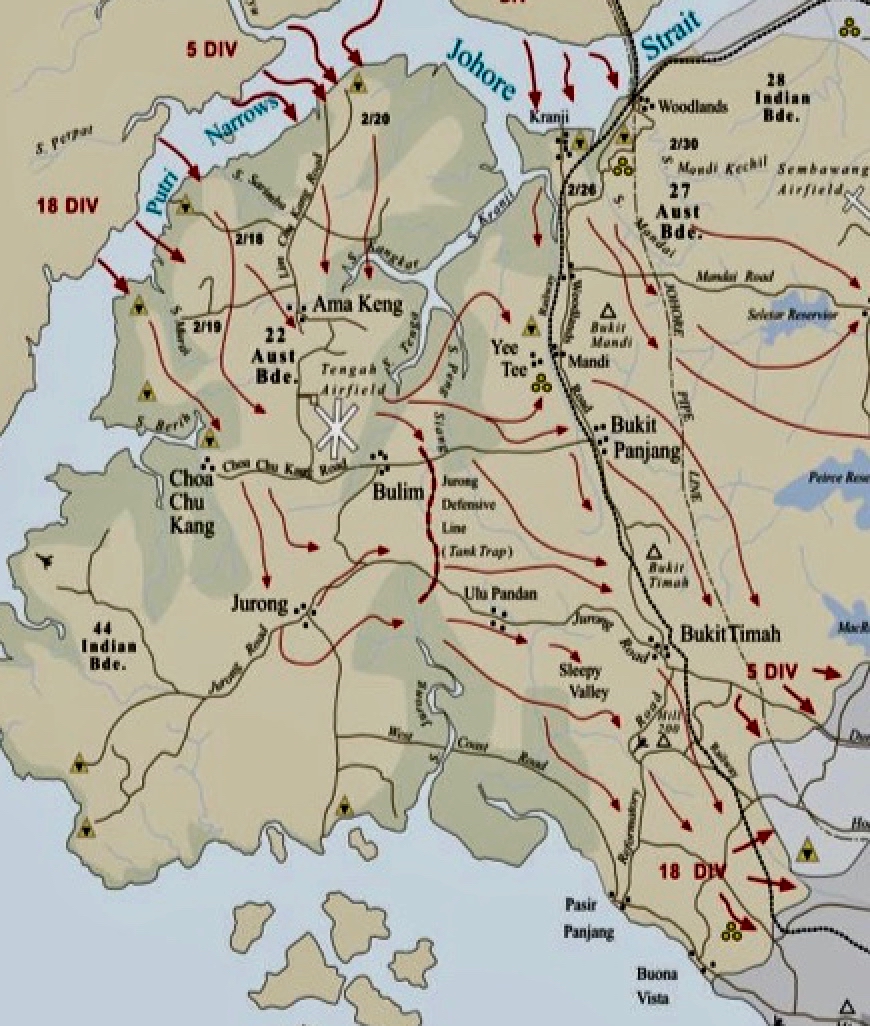
16 Platoon was made up of 27 men
By Surrender on 15 Feb 1942
9 men KIA
3 Men WIA evacuated 8/9th Feb
3 men shell-shocked
(Harrison did runner & boarded ship to Fremantle,
Wilson MIA 8/2 returned to Unit 15 Feb,
Richard Annear escaped Sumatra, Wood escaped to Java )
8 Men Standing
.
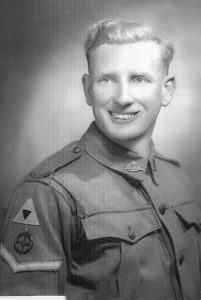
Above 16 Platoon Corporal WX9080 L/Cpl Albert ‘Bert’ W Stribley 30 years (Formerly Coy HQ & No 15 Platoon) – was KIA 9 Feb 1942 West coast of Singapore (his brother Norm Stribley also joined ‘D’ Company, served 13 Platoon. Was recovered from Thailand at end of war).;
Privates
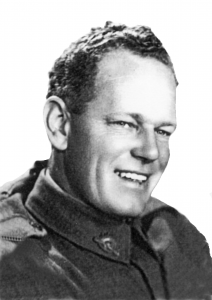
WX13468 Pte Richard Winston ANNEAR (transf from 13 Platoon) escaped to Sumatra, worked on the Sumatran Railway. Survived war.
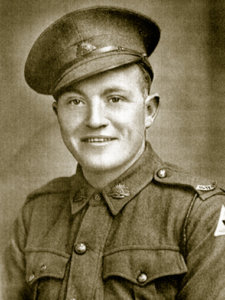
WX7444 Pte Arthur Richard ‘Bill’ Attenborough (formerly 15 Platoon) – ‘B’ Force Borneo died 12 Apr 1945 Ranau area (28 years) having marched from Sandakan.
WX7796 Pte Joseph John Samuel Barras (formerly 15 Platoon) – Was with a party which scattered under heavy fire. Last seen 11 Feb 1942 by WX8958 William Gibbs at Tanjong Murai. KIA
WX10805 Pte Reginald James Brown (formerly 13 Platoon) – Withdrawing from coast, this party came under heavy fire from Japanese small arms. Brown & several others never sighted again until KIA Lin Chu Kang Road aged 22 years.)
WX7148 Pte Maurice Lester Browne (formerly14 Platoon) – 38 years KIA 9 Feb 1942 14 mile peg Lim Chu Kang Road
WX9060 Pte Alfred Thomas ‘Tom’ James Cato despatch rider (formerly Coy HQ moved to 13 Platoon then to 16 Platoon) – worked Burma-Thai Railway with ‘D’ Force S & U Battalions. He was recovered from Thailand.
WX7997 Pte Herbert ‘Bert’ Dorrizi (formerly Driver HQ Coy) – ‘B’ Force Borneo d. 11 Feb 1945 Sandakan (26 years). Dorizzi’s two brothers also died Borneo.
WX7620 Pte Thomas Henry (Tom) Edwards (formerly 14 Platoon) – wounded in trench by shell burst from enemy artillery fire at Hill 200, Ulu Pandan.
Stretcher bearers carried him to the Regimental Aid Post where Capt Anderson of 2/4 MGB pronounced him dead, Tom was 42 years old. It was 12 Feb 1942.
Tom enlisted 10 Aug 1940.
As a young couple,Tom with his wife migrated to WA from England and took up land at Busselton with Group Settlement. He had served with British Forces in WW1. He had several adult children as well as grandchildren.
WX9497 Pte Benjamin (Bob) Evans – Shell-shocked at Buona Vista on 13 Feb and evacuated on 15 Feb 1942.
Worked on Burma-Thai Railway with ‘F’ Force He was medical orderly at Shimo Sonkurai. Returned to Singapore and was recovered end of the war from Kranji Hospital Camp Woodlands where he had been since 28 May 1944.
Please read about ‘F’ Force Thailand
Right: Evans
WX16407 Pte Lacey Gordon Gibbs (formerly 13 Platoon) – Green Force to Burma. Perished ‘Rakuyo’ Maru 14 Sep 1944 South China Sea (27)
WX8958 Pte William Herbert (Jim) Gibbs (formerly 13 Platoon) – brother of above Green Force to Burma, perished ‘Rakuyo’ Maru 12 Sep 1944 (28).
The Gibbs brothers were from a large family undertaking mixed farming at Wanneroo which at that time, was considered remote with a small population.
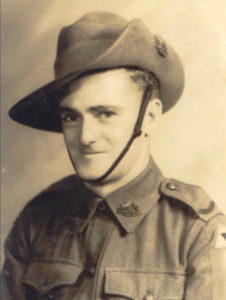
WX7745 B G Harrison (formerly 15 Platoon) – disappeared when Arbery was leading the men out of their front line positions under heavy fire and about to fall to the Japanese on the night of 9 Feb 1942. It was later found Harrison had got himself onto a civilian ship at the Singapore wharves and arrived Fremantle on ‘Edindale’ 5 March 1942. He would not have been able to board the ship in his military clothes (there were military police ensuring only civilians board ‘Edindale’) and obviously shed his uniform to sneak on board. Harrison was never welcomed at 2/4th reunions.
WX7029 Pte HILL, Ernest (Ernie) Thornton – (formerly 15 Platoon) ‘B’ Force – died Borneo at Sandakan 25 May 1945 aged 27 years.
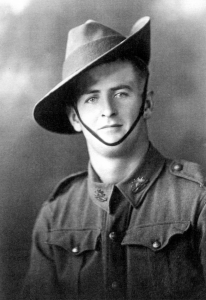
With the creation of an additional Machine Gun Platoon in ‘D’ Company he was transferred to 16 Platoon, which together with 14 Platoon was attached to the 2/19th Infantry Battalion and occupied beach positions on the W NW shore of Singapore Island in the vicinity of the Sungei Berih Inlet. The platoon was in action during the landing until cut off and were forced to break through the encirclement. Ernie was in a section of Machine Gunners seven strong, who were ambushed, he was one of the only two survivors.
Please read about Sandakan, Borneo
WX9286 Pte Charles Holmes (formerly 15 Platoon) – Green Force to Burma. Recovered from Thailand.
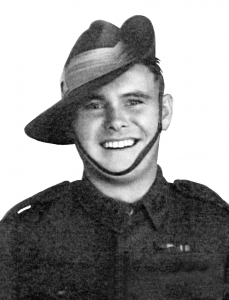
WX7441 Pte T H ‘Tommy’ Lewis (Formerly 14 Platoon) – Shell shocked 14 Feb 1942 and evacuated to AGH at Roberts Barracks Changi on 18th Feb with early stages of encephalitis. Remained in a coma drifting between life and death for nearly three weeks – survived but thereafter suffered speech and eye disability, initially unable to speak or walk. On return to WA he underwent treatment, but sadly Tommy never fully recovered.
WX7330 Pte Ellis Shackleton (formerly 15 Platoon) – 27 years. Missing in Action 11 Feb 1942 West coast of Singapore – believed killed or badly wounded.
Below: L-R Shackleton and Stuart.
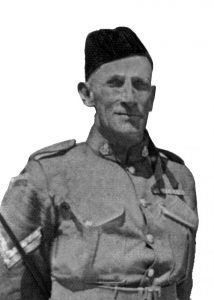
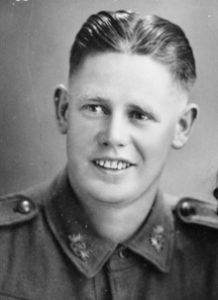
WX14495 Pte William George Raymond Stuart (14 Platoon) KIA 49 years 9 Feb 1942 14 mile peg, Lim Chu Kang Road – coming from west coast of Singapore – group split up under enemy small arms fire (formerly WW1 16th Btn Veteran, Staff Sgt & Vickers gun instructor 16th Btn Militia)
WX8180 Pte Frederic Laurence Taylor (formerly 15 Platoon) – badly shell shocked following heavy artillery barrage, as were so many.
Known as ‘Laurie’, he enlisted 18 Oct 1940.
6 ft tall Taylor was only 22 years old when KIA 9 Feb 1942 Tanjong Murai.
From a large Fremantle family, he was formerly employed as a civil servant.
Right: Laurie Taylor
WX9002 Pte Harry Charles Frederick WHITE (formerly 13 Platoon) – ‘D’ Force Thailand, Capt Fred Harris Party. He was sighted by Capt George Gwynne of ‘F’ Force. Recovered from Ubon at end of war.
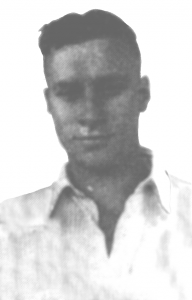
WX7499 Pte Ralph Thomas Williams (formerly 15 Platoon) shell-shocked at Ulu Pandan on 12 Feb 1942. ‘D’ Force Thailand ‘S’ Battalion to Burma-Thai Railway. He was recovered from Nakom Nayok.
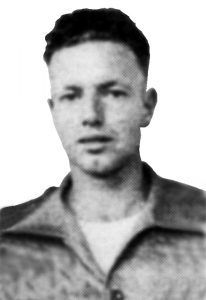
WX5073 Pte Thomas Ashton Wood (formerly 14 Platoon) – Listed as missing from 9 Feb 1942. He had escaped to Java. Recovered from Batavia and flown to Singapore at end of war. Wood did not join any work parties to leave Java.
Reinforcements
WX13079 Pte ELLIS Ronald (Ron) ( Reinforcement ) WIA 10 Feb 1942 GSWs right arm & shrapnel wound chest. Arm was amputated2″ below shoulder at 2/13th AGH. DOW 11 Feb 1942 aged just 21 years.
Wagin born Ron arrived with the reinforcements on ‘Aquitania’ with 2/4th. He was Ron was one of three reinforcements sent to 16 Platoon. Please read of his bravery
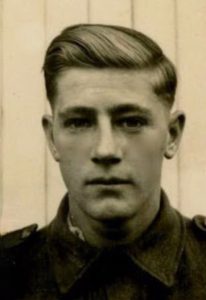
WX12157 Pte Edward Charles Hardey – Reinforcement wounded with gunshot to right buttock and leg 10 Feb 1942 and evacuated. Admitted to 2/10th Field Ambulance then to 2/13th AGH transferred to 2/10th AGH on 6 March 1942. Discharged to unit 27 Mar 1942. Green Force to Burma. ‘Awa’ Maru to Japan. Recovered from Omuta, Japan. RTA
WX17370 Pte WILSON, John – missing in action from 9 Feb. He rejoined Unit on 15 Feb. Worked on Burma-Thai Railway with ‘F’ Force Thailand. Critically ill Kranji Hospital, Woodlands with beri beri, malaria and dysentery Recovered & returned to Australia.
Please read further about ‘D’ Company, No. 15 Platoon Under Commanding Officer Lt. Meiklejohn who was KIA.
Read about 14 Platoon under Commanding Officer Lt Tompkins
D Company 13 Platoon under Commanding Officer Lt Wankey

